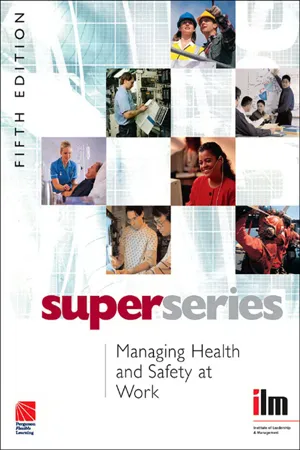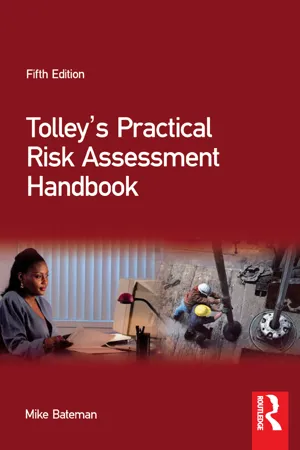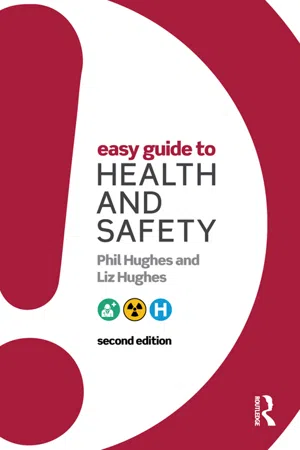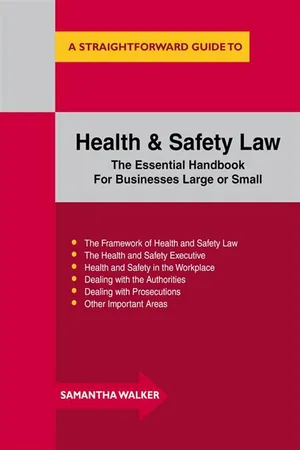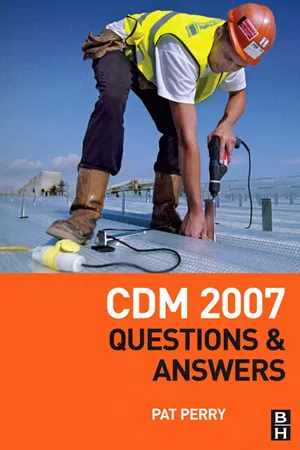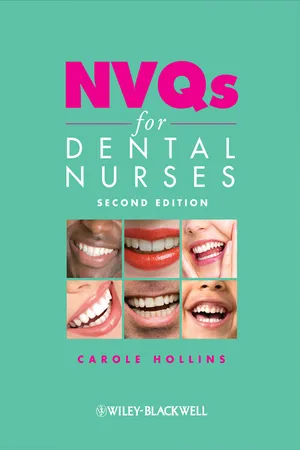Technology & Engineering
COSHH
COSHH stands for Control of Substances Hazardous to Health. It is a set of regulations designed to protect people from health risks associated with hazardous substances in the workplace. COSHH requires employers to assess and control the risks from hazardous substances and provide information, instruction, and training to employees who may be exposed to such substances.
Written by Perlego with AI-assistance
Related key terms
8 Key excerpts on "COSHH"
- eBook - ePub
- Institute of Leadership & Management(Author)
- 2013(Publication Date)
- Routledge(Publisher)
So much for the six Regulations that form the ‘six pack’. Now we will look at another very important set of Regulations.8 Control of Substances Hazardous to Health Regulations 1994 (COSHH)
The Control of Substances Hazardous to Health Regulations (COSHH) potentially affect any substance used for any purpose in the workplace. Even food ingredients can be hazardous in some circumstances. Sugar can be involved in dust explosions and flour can be implicated in occupational asthma.COSHH doesn’t cover asbestos, lead, materials producing ionizing radiation and substances below ground in mines, which all have their own legislation.The Regulations require users to carry out risk assessments on every potentially hazardous substance and to take appropriate action when the assessment has been made.Activity 21
Can you think of any substances which could possibly affect the health of people where you work? _________________________________________________________________________________ _________________________________________________________________________________ _________________________________________________________________________________ _________________________________________________________________________________ _________________________________________________________________________________ _________________________________________________________________________________ _________________________________________________________________________________ _________________________________________________________________________________There are over 40,000 substances which are classed as hazardous. Wherever you work – in a food factory, a shop, a garage, a warehouse, a laboratory, an engineering works, a hospital, a farm, a garden centre or an office – hazardous substances will probably be present. They may include: - eBook - ePub
- Mike Bateman(Author)
- 2006(Publication Date)
- Routledge(Publisher)
(Regulation 7) being the most notable change.They are the principal Regulations affecting the use of hazardous substances, although there are separate Regulations dealing with asbestos and lead. The Regulations follow general principles which can be applied to most occupational health risks.- Assess the risk – What substances are in use, in what ways and to what extent.
- Eliminate the risk – If possible, stop using the hazardous substance or replace it by a less hazardous one, e.g. substitute solvent-based paints by water-based ones.
- Provide controls – Control at source, e.g. by enclosure or local exhaust ventilation (LEV) is preferable, although it may be necessary to rely on PPE.
- Maintain the controls – Control measures, e.g. LEV and PPE must be checked regularly and maintained in good condition.
- Monitor – Check on working conditions and working practices regularly. Atmospheric sampling or health surveillance may be necessary.
- Inform employees – About the risks from substances they are using, the precautions they should be following, how to use LEV and PPE etc.
Full details of the 2002 Regulations together with an ACOP and guidance are available in an HSE booklet (REF. 1). New editions are published periodically to take account of subsequent amendments.How substances cause harm
9.2 Before carrying out assessments under the COSHH Regulations it is necessary to have an understanding of how hazardous substances can harm the body.Entry routes
9.3 Hazardous substances may be present in different forms such as:- Solids
- Dusts
- Smoke
- Fumes
- Liquid
- Mists and aerosols
- Vapour
- Gas.
- Inhalation
- eBook - ePub
- Phil Hughes, Liz Hughes(Authors)
- 2015(Publication Date)
- Routledge(Publisher)
• assess the level of danger for each hazardous substance by determining the effects of each substance used on the premises. This is called a COSHH assessment and will include taking precautionary measures;• decide what precautions are needed in order to prevent anyone from being exposed, e.g. safety equipment, clothing or ventilation;• choose the best control measures for each substance, e.g. limiting use to a number of people, reducing time of exposure or using the substance in a controlled area. The principles of good practice set out in the regulations should be followed – see box below;• - eBook - ePub
Health And Safety Law
A Straightforward Guide
- (Author)
- 2015(Publication Date)
- Straightforward Publishing Digital(Publisher)
Chapter 4
From Asbestos to Zoonoses: General Health and Safety Topics
Chemicals, Substances and Explosive Atmospheres Hazardous Substances Key legislation: The Control of Substances Hazardous to Health Regulations 2002 (amended 2004). Also known as the ‘COSHH Regulations.’Under the above legislation dutyholders are required to do a risk assessment for all substances and chemicals they use at work which may affect the health of employees and others, and to control exposure to them. It includes substances like paints, glues, cleaning products, chemicals, some substances produced in a work process (even as a by-product), biological agents (which are micro-organisms such as bacteria that can cause viruses, allergies and diseases) and certain dusts. Also included are fumes that are produced in a work process – such as those found in welding, or when mixing certain chemicals together. Many hazardous substances can have nasty side effects on the body and human health – some are known or thought to cause cancer, some can cause asthma and breathing difficulties and many effects that substances can have on human life can be long-term or permanent. COSHH assessments do not need to include substances dangerous to safety (such as explosives and flammables) as these come under The Dangerous Substances and Explosive Atmospheres Regulations (DSEAR). Asbestos and lead are also not included in the Regulations as they have their own specific legislation.To start with, you initially need to identify any hazardous substances that you use, and then look at the information which accompanies the substance. This is called the material safety data sheet (MSDS) and a substance will usually have one of these if it is classified as dangerous to health. To see if a substance has this classification, the label of the container will normally have a hazard sign on it – this is a black and orange symbol depicting an image (think of the well-known skull and cross-bones picture) with a short description underneath it detailing the hazard (irritant, corrosive , for example.) Don’t forget that we are only looking at substances dangerous to health - Examples of the effects of hazardous substances include: • Skin irritation and dermatitis • Asthma • Respiratory conditions • Loss of consciousness as a result of being overcome with toxic fumes • Cancer • Infection from bacteria.26.3 When is a substance classed as hazardous under COSHH?If a substance or mixture of substances is classified as dangerous under the Chemicals (Hazard, Information and Packaging for Supply) Regulations (CHIP) then the COSHH Regulations apply to it. Dangerous substances can be identified by their warning label and the supplier must provide safety data sheets for all hazardous substances. The Health and Safety Executive publish lists of the most commonly used dangerous substances. Substances which have an Occupational Exposure Limit (OEL) are classified as hazardous. These are substances which can be considered “safe” up to certain exposure limits. Any kind of dust in concentrations specified in the Regulations is deemed to be harmful.COSHH does not cover asbestos and lead as these are dealt with under specific legislation.26.4 What types of substances in use on a construction site could be considered as hazardous?The following are commonly in use on construction sites and could be considered as a hazardous substance under COSHH: • Solvents • Silica • Cement • Mineral oils • Carbon monoxide gas • Carbon dioxide gas • Adhesives • Paints • Wood dusts • Welding fumes • Carbon deposits/soot • Acid cleaners • Detergents/degreasers • Pesticides. Details from the suppliers or manufacturers must be obtained for all substances planned to be used on site, or brought in by others to be used on site.Remember, whilst the operatives in the immediate vicinity of the hazardous substance may be protected by PPEs, others working some distance away could be affected by the substances, fumes, vapours, mists or dust.Case StudyTwo lift engineers were working in the lift shaft, welding the metal frame. They were adequately protected by PPE and had a local exhaust ventilation system which removed the welding fumes. However, unbeknown to them, the exhaust extract was faulty because it had not been subjected to regular inspection and the welding fumes were leaking into the roof void above the lift shaft in which two operatives were laying electrical cables. Both operatives in the roof void were overcome by fumes and were found when the Site Agent checked on progress of works.
- eBook - ePub
- Carole Hollins(Author)
- 2013(Publication Date)
- Wiley-Blackwell(Publisher)
Figure 2.6 ).Figure 2.6 COSHH hazard signs. Source: Levison’s Textbook for Dental Nurses , 10th edn, C. Hollins, 2008, Wiley-Blackwell.These symbols will appear on the substance packaging, along with information on the actions to take in the event of an accident; all of this information will be included in the COSHH report of each substance.Other hazardous substances found specifically in the dental workplace are:The COSHH assessment will follow the stages set out below for each of the substances:Ionising radiation – as it has a maximum exposure limitMicro-organisms – present on all items and equipment contaminated by the body fluids of patients(1) Identify those substances which are hazardous, by reading the manufacturers’ leaflets, which should accompany the product(2) Identify who may be harmed – usually all persons using the substance Identify how they may be harmed – breathing in, irritant to eyes or skin, etc.(3) Evaluate the risk of the substance(4) Determine whether health monitoring is required (mercury exposure, for example)(5) Control the risks, or reduce them as far as possible(6) Inform all staff of the risks (show sheets and sign to say they have read and understood them)(7) Record the assessment and review and update it regularlyEach substance will have the relevant details entered onto an evaluation sheet, set out in the same way for ease of reference (Figure 2.7 - eBook - ePub
- (Author)
- 2016(Publication Date)
- For Dummies(Publisher)
- Scientific knowledge is in constant development – you only recognise that a chemical substance is hazardous when you find out about the issues around its use. It pays to be a little cautious and to review current data every now and then. It’s sobering when you realise how much is out there yet to be discovered.
You need to work out the best ways to control chemical substances in your workplace. But no need to feel overwhelmed – help is at hand. In the following sections, we look at the control measures you can implement to reduce exposure.Practicing the principles of good practice
The principles of good practice are a set of overriding approaches set out in the COSHH Regulations 2002 to help control hazardous substances. There are eight in total:- Principle 1: Design and operate processes and activities to minimise the emission, release and spread of substances hazardous to health. This principle helps you to design the process to minimise the substance contact with employees or change the operation to do the same. Elimination is ideal but not always possible, so look to substitute one of your nasties with a less hazardous option or introduce other controls to reduce the impact of the substance if you just can’t eliminate the risk.
- Principle 2: Take into account all relevant routes of exposure – inhalation, skin and ingestion – when developing control measures.
- eBook - ePub
- Chris March(Author)
- 2009(Publication Date)
- Routledge(Publisher)
RIDDOR Explained: Reporting of Injuries, Diseases and Dangerous Occurrences Regulations. HSE.Health and Safety Executive (2005) Workplace Exposure Limits: Containing the List of Workplace Exposure Limits for Use with the Control of Substances Hazardous to Health Regulations 2002 (as amended). EH40/2005. HSE.Health and Safety Executive (2007) Managing Health and Safety in Construction. Construction (Design and Management) Regulations 2007. (CDM) Approved Code of Practice. L144. HSE.The Control of Substances Hazardous to Health (Amendment) Regulations 2002 The Health and Safety (Display Screen Equipment) Regulations 1992 The Management of Health and Safety at Work Regulations 1992 The Manual Handling Operations Regulations 1992 The Personal Protective Equipment at Work Regulations 1992 The Provision and Use of Work Equipment Regulations 1992 The Reporting of Injuries, Diseases and Dangerous Occurrences Regulations 1995 The Workplace (Health, Safety and Welfare) Regulations 1992
Learn about this page
Index pages curate the most relevant extracts from our library of academic textbooks. They’ve been created using an in-house natural language model (NLM), each adding context and meaning to key research topics.
